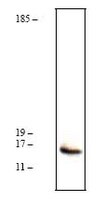PC409 Sigma-AldrichAnti-p14ARF (Ab-1) (118-132) Rabbit pAb
This Anti-p14ARF (Ab-1) (118-132) Rabbit pAb is validated for use in Immunoblotting for the detection of p14ARF (Ab-1) (118-132).
More>> This Anti-p14ARF (Ab-1) (118-132) Rabbit pAb is validated for use in Immunoblotting for the detection of p14ARF (Ab-1) (118-132). Less<<Empfohlene Produkte
Übersicht
| Replacement Information |
|---|
Key Spec Table
| Species Reactivity | Host | Antibody Type |
|---|---|---|
| H | Rb | Polyclonal Antibody |
| Product Information | |
|---|---|
| Declaration | Sold under license of U.S. Patent 6,482,929. |
| Form | Liquid |
| Formulation | Undiluted serum. |
| Positive control | Saos-2 cells |
| Preservative | ≤0.1% sodium azide |
| Applications | |
|---|---|
| Key Applications | Immunoblotting (Western Blotting) |
| Application Notes | Immunoblotting (1:500) |
| Application Comments | Antibody should be titrated for optimal results in individual systems. |
| Physicochemical Information |
|---|
| Dimensions |
|---|
| Materials Information |
|---|
| Toxicological Information |
|---|
| Safety Information according to GHS |
|---|
| Safety Information |
|---|
| Product Usage Statements |
|---|
| Packaging Information |
|---|
| Transport Information |
|---|
| Supplemental Information |
|---|
| Specifications |
|---|
| Global Trade Item Number | |
|---|---|
| Bestellnummer | GTIN |
| PC409 | 0 |
Documentation
Anti-p14ARF (Ab-1) (118-132) Rabbit pAb SDB
| Titel |
|---|
Anti-p14ARF (Ab-1) (118-132) Rabbit pAb Analysenzertifikate
| Titel | Chargennummer |
|---|---|
| PC409 |
Literatur
| Übersicht |
|---|
| Sharpless, N.E., and DePinho, R. A., 1999. Curr. Opin. Genet. Devel. 9, 22. Bates, S., et al. 1998. Nature 395, 124. Gorgoulis, V.G., et al. 1998. Am. J. Pathol. 153, 1749. Pomerantz, J., et al. 1998. Cell 92, 713. Stott, F.J., et al. 1998. EMBO J. 17, 5001. Vonlanthen, S., et al. 1998. Oncogene 17, 2770. Zhang, Y., et al. 1998. Cell 92, 725. |








